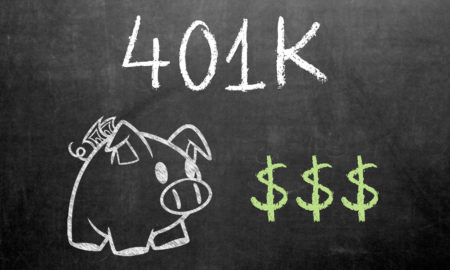

401(k)s are a special type of retirement account that can be offered by employers as a benefit for their employees.
Your 401(k) investment options are determined by the company that your employer has partnered with to manage the 401(k) accounts. This means that the best 401(k) investment strategy will vary by employer because each employer’s offerings are different.
Still, there are a few things to look out for that apply to any 401(k), and in fact, any investment account you open.
What Options Do I Have?
The vast majority of 401(k)s offer a selection of mutual funds to invest in. Most also offer the option to keep your money in a money market account, which is very similar to a savings account and earns minimal interest. Unless you are very close to retirement, you’ll actually lose money to inflation by keeping your 401(k) in a money market, so you should look at the mutual funds that are offered.
A mutual fund is a type of investment that lets you spread your money across a wide number of stocks, bonds or both. A mutual fund could focus on a specific type of business, owning only stocks in medical companies, or only stocks in very large business. It could also focus on specific types of bonds, owning only US government bonds, or only high-interest corporate bonds.
Index funds are a type of mutual fund that holds a diversified group of stocks that represent a full stock index, such as the S&P 500. These stocks represent a huge variety of types of business, so owning an index fund is a good way to diversify your investments.
Target Date funds are another type of mutual fund specifically designed to help people plan for retirement. Early in your life, you have a long time to wait before you reach normal retirement age. That means that you can accept more risk and volatility in your retirement savings in search of higher returns. As you get closer to retiring, you can’t accept as much risk or volatility since you’ll be needing to spend that money soon.
Target Date funds help you plan for retirement by initially holding a lot of high-risk, high-reward stocks, and transitioning to holding more low-risk bonds as the target date gets closer.
If you plan to retire in 2060 for example, you can purchase a Target Date 2060 fund which might hold a 90/10 split of stocks to bonds now. By 2030, the split might be 80/20 and by 2060, the split might be 50/50.
Target Date funds are great for set it and forget it retirement savings since they automatically adjust their risk as your needs change.
Diversification
As mentioned in the previous section, the mutual funds offered by 401(k)s let you invest in a number of stocks and bonds at once. But just because you own a lot of stocks does not mean you are diversified. If the mutual fund you’ve invested in only holds stocks in a specific type of business an event that disproportionately affects that sector of the economy could hurt your investments.
For example, banks were heavily impacted by the 2008 financial crisis, but companies that provide necessities, like utility companies, were less affected. If your mutual fund only held financial stocks you would take a gigantic loss. If you invested in a mutual fund that held stocks in all the sectors of the economy, your losses would have been lessened.
Another type of diversification to look for is international diversification. Just because you live in the United States doesn’t mean you need to only invest in American companies. The same holds for any country you may live in. You can invest in any publicly traded company on Earth, no matter where they’re based. Though international investment has its own pitfalls, investing in a mutual fund that holds some international stocks does provide additional diversification which can help if your country’s markets slow down.
If your 401(k) doesn’t offer one fund that lets you diversify into all the types of investments that you’d like, you are free to invest in multiple funds. Though it can be more complicated to handle it is worth it to diversify your investments.
Fee Structure
Mutual funds let you invest easily, but there is a price to pay for the convenience. Mutual funds charge fees that let them stay running and earn a profit for the company that manages the funds. Depending on the size of the fees, they can really impact your overall return.
Investment Loads
A load fee is a fee that is paid when you buy or sell your investments. A front-end load is a fee paid when you make a purchase. A back-end load is paid when you sell. These fees are often charged as a percentage of the transaction, so a 2% front-end load means that you’ll only be purchasing $98 worth of mutual fund for every $100 you try to put in. Similarly, a 2% back-end load means you’ll only get $98 for every $100 you try to withdraw.
The good news is that load fees are relatively rare in 401(k) investments and there are often ways to avoid them, such as holding your investments for a certain amount of time before selling.
Expense Ratio
Expense ratios are much more common than load fees because all mutual funds charge them. They reflect the cost that the fund manager incurs when running the fund.
Expense ratios are also quoted as a percentage, which is the percentage of your total investment you’ll pay each year to stay invested in the fund.
Expense ratios aren’t visibly charged, you won’t see a charge appear on your account to cover the fee. Instead, when the fund manager calculates the value of each share at the end of a trading day, that number will automatically take the expense ratio into account.
Some funds have low expense ratios, below .1%. Other funds’ expense ratios can be 1% or more. Though 1% might not sound like a lot, it can have a huge effect over time.
This example will illustrate how the expense ratio can create a drag on your overall returns.
You start working and plan to invest $5,000 per year for 40 years, earning 10% returns annually. At the end of the 40 years, you’ll have $2.66 million.
If you invested in the mutual fund with a .1% expense ratio, you would have earned a 9.9% return annually. By the end of the 40 years, your balance would be $2.58 million, $80,000 less than if there was no expense ratio.
If you invested in the fund with a 1% expense ratio, your annual returns would be 9%. By the end of the 40 year period, you’d have a balance of $2 million. The fees would reduce your wealth by more than $600,000. That’s why you should look for low-cost investments that fit your investment risk profile. Even small fees can have huge effects.
You can use Personal Capital’s 401(k) fee analyzer to determine the effect that your investment options fees will have on your overall returns.
Rebalance Regularly, If Necessary
If you didn’t choose a Target Date fund that automatically manages the amount you have invested in stocks vs. bonds, or if you’ve invested in multiple funds, you’ll need to rebalance on occasion.
When you first invest, you should decide what percentage of your money should be allocated to each fund. Over time, the amount actually invested in each fund will change based on the funds’ performances. Bonds may do well one year while stocks do poorly.
Rebalancing is the act of moving money between funds to preserve the asset allocation you decided on. You’ll also need to revisit the allocation you’ve settled on as you get closer to retirement age.
Photo credit: 401(K) 2012 | Flickr



















